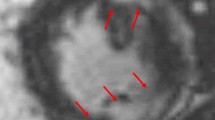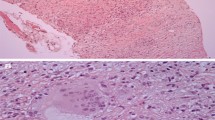Abstract
Purpose of Review
Cardiac involvement is increasingly being recognized as a cause of significant morbidity and mortality in patients with sarcoidosis. Unfortunately, imaging cardiac sarcoidosis (CS) remains a challenge and often relies on advanced imaging modalities. The aim of this review is to provide an up-to-date overview of the role of molecular imaging for the diagnosis of cardiac sarcoidosis, with particular emphasis on the use of FDG and non-FDG PET.
Recent Findings
In the last few years, FDG-PET has established itself as an accurate imaging study for the assessment of CS. New diagnostic criteria have recently appeared which incorporate FDG-PET findings in the diagnostic workup for CS. In addition, a joint SNMMI-ASNC Expert Consensus document has appeared on the role of FDG-PET in CS. Recent advances in the field have focused on the role of PET for diagnosis, assessment of therapy, and use of non-FDG tracers to image myocardial inflammation.
Summary
The role of PET is rapidly evolving but is now firmly established as an important component in the imaging assessment of CS.







Similar content being viewed by others
References
Papers of particular interest, published recently, have been highlighted as: • Of importance •• Of major importance
Judson MA, Boan AD, Lackland DT. The clinical course of sarcoidosis: presentation, diagnosis, and treatment in a large white and black cohort in the United States. Sarcoidosis Vasc Diffuse Lung Dis. 2012;29:119–27.
Nery PB, Beanlands RS, Nair GM, Green M, Yang J, Mcardle BA, et al. Atrioventricular block as the initial manifestation of cardiac sarcoidosis in middle-aged adults. J Cardiovasc Electrophysiol. 2014;25:875–81, 8. https://doi.org/10.1111/jce.12401.
Nery PB, Keren A, Healey J, Leug E, Beanlands RS, Birnie DH. Isolated cardiac sarcoidosis: establishing the diagnosis with electroanatomic mapping-guided endomyocardial biopsy. Can J Cardiol. 2013;29(8):1015.e1–3. https://doi.org/10.1016/j.cjca.2012.09.009.
•• Birnie DH, Sauer WH, Bogun F, Cooper JM, Culver DA, Duvernoy CS, et al. HRS expert consensus statement on the diagnosis and management of arrhythmias associated with cardiac sarcoidosis. Heart Rhythm. 2014;11:1304–23. Birnie et al. published a new set of diagnostic criteria which included the results of FDG PET in the diagnostic workup of CS.
Pelletier-Galarneau M, Ardle BM, Ohira H, Leung E, Ruddy TD. Role of PET/CT in assessing cardiac sarcoidosis. Mol Multimodality Imaging Cardiovasc Dis Springer International Publishing; 2015. p. 49–78, DOI: https://doi.org/10.1007/978-3-319-19611-4_4.
•• Youssef G, Leung E, Mylonas I, Nery P, Williams K, Wisenberg G, et al. The use of 18F-FDG PET in the diagnosis of cardiac sarcoidosis: a systematic review and metaanalysis including the Ontario experience. J Nucl Med. 2012;53:241–8. Systematic review and meta-analysis examining the sensitivity and specificity of FDG-PET for CS.
•• Chareonthaitawee P, Beanlands RS, Chen W, Dorbala S, Miller EJ, Murthy VL, et al. Joint SNMMI–ASNC expert consensus document on the role of 18F-FDG PET/CT in cardiac sarcoid detection and therapy monitoring. J Nucl Med. 2017;58:1341–53. The joint SNMMI-ASNC guidelines discussing the use of cardiac PET for CS. This document provides recommendations on the technical aspects of PET, discusses indications, and reviews clinical scenarios in which PET/CT may be useful.
•• Blankstein R, Osborne M, Naya M, Waller A, Kim CK, Murthy VL, et al. Cardiac positron emission tomography enhances prognostic assessments of patients with suspected cardiac sarcoidosis. J Am Coll Cardiol. 2014;63:329–36. Blankstein et al. studied 118 patients and showed that the presence of focal perfusion defects and FDG uptake was associated with adverse events. The authors suggested that the PET findings offered prognostic value beyond the JMHW criteria.
Ambrosini V, Zompatori M, Fasano L, Nanni C, Nava S, Rubello D, et al. 18F-FDG PET/CT for the assessment of disease extension and activity in patients with sarcoidosis: results of a preliminary prospective study. Clin Nucl Med. 2013;38:e171–7, 4. https://doi.org/10.1097/RLU.0b013e31827a27df.
Soussan M, Brillet P-Y, Nunes H, Pop G, Ouvrier M-J, Naggara N, et al. Clinical value of a high-fat and low-carbohydrate diet before FDG-PET/CT for evaluation of patients with suspected cardiac sarcoidosis. J Nucl Cardiol. 2013;20:120–7, 1. https://doi.org/10.1007/s12350-012-9653-3.
• Ahmadian A, Brogan A, Berman J, Sverdlov AL, Mercier G, Mazzini M, et al. Quantitative interpretation of FDG PET/CT with myocardial perfusion imaging increases diagnostic information in the evaluation of cardiac sarcoidosis. J Nucl Cardiol. 2014;1:925–39. This study demonstrated that increased myocardial FDG uptake correlated with decreased EFs, clinical events, and showed a response to immunosuppression treatment.
Manabe O, Yoshinaga K, Ohira H, Sato T, Tsujino I, Yamada A, et al. Right ventricular 18F-FDG uptake is an important indicator for cardiac involvement in patients with suspected cardiac sarcoidosis. Ann Nucl Med. 2014;28(7):656–63. https://doi.org/10.1007/s12149-014-0860-7.
•• Tang R, Wang J, Wang L, Huang Y, Hickey Y, Emmett L. Impact of patient preparation on the diagnostic performance of 18F-FDG PET in cardiac sarcoidosis: a systematic review and meta-analysis. Clin Nucl Med. 2016;41:e327–39. Systematic review and meta-analysis which examined various techniques to suppress normal myocardial uptake of FDG and the impact on the sensitivity and specificity of FDG-PET for CS.
• Ohira H, Ardle BM, de Kemp RA, Nery PB, Juneau D, Renaud JM, et al. Inter- and intra-observer agreement of FDG-PET/CT image interpretation in patients referred for assessment of cardiac sarcoidosis. J Nucl Med. 2017;jnumed.116.187203. Study showing moderate inter-observer variability in the interpretation of cardiac FDG uptake, which was dependent on pre-scan diet.
Morooka M, Moroi M, Uno K, Ito K, Wu J, Nakagawa T, et al. Long fasting is effective in inhibiting physiological myocardial 18F-FDG uptake and for evaluating active lesions of cardiac sarcoidosis. EJNMMI Res. 2014;4(1):1. https://doi.org/10.1186/2191-219X-4-1.
Crouser ED, Ono C, Tran T, He X, Raman SV. Improved detection of cardiac sarcoidosis using magnetic resonance with myocardial T2 mapping. Am J Respir Crit Care Med. 2014;189:109–12.
• Ohira H, Birnie D, Pena E, Bernick J, Mc Ardle B, Leung E, et al. Comparison of 18F-fluorodeoxyglucose positron emission tomography (FDG PET) and cardiac magnetic resonance (CMR) in corticosteroid-naive patients with conduction system disease due to cardiac sarcoidosis. Eur J Nucl Med Mol Imaging. 2016;43:259–69. Recent comparison of the diagnostic performance of FDG-PET compared to CMR. The authors concluded that PET was more sensitive for the detection of acute cases of CS, while CMR was more sensitive for the fibrosis of chronic CS.
Schneider S, Batrice A, Rischpler C, Eiber M, Ibrahim T, Nekolla SG. Utility of multimodal cardiac imaging with PET/MRI in cardiac sarcoidosis: implications for diagnosis, monitoring and treatment. Eur Heart J. 2014;35(5):312–2. https://doi.org/10.1093/eurheartj/eht335.
Wada K, Niitsuma T, Yamaki T, Masuda A, Ito H, Kubo H, et al. Simultaneous cardiac imaging to detect inflammation and scar tissue with 18F-fluorodeoxyglucose PET/MRI in cardiac sarcoidosis. J Nucl Cardiol. 2016;23:1180–2, 5. https://doi.org/10.1007/s12350-015-0348-4.
Zandieh S, Bernt R, Mirzaei S, Haller J, Hergan K. Image fusion between 18F-FDG PET and MRI in cardiac sarcoidosis: a case series. J Nucl Cardiol. 2016:1–7.
Hanneman K, Kadoch M, Guo H, et al. Initial experience with simultaneous 18F-FDG PET/MRI in the evaluation of cardiac sarcoidosis and myocarditis. Clin Nucl Med. 2017;42:e328–34.
•• Osborne MT, Hulten EA, Singh A, Waller AH, Bittencourt MS, Stewart GC, et al. Reduction in 18F-fluorodeoxyglucose uptake on serial cardiac positron emission tomography is associated with improved left ventricular ejection fraction in patients with cardiac sarcoidosis. J Nucl Cardiol. 2014;21:166–74. Article demonstrating that a reduction in the degree of FDG uptake by the myocardium is associated with an improvement in EF, suggesting a possible role for serial monitoring by FDG-PET.
• Lee P-I, Cheng G, Alavi A. The role of serial FDG PET for assessing therapeutic response in patients with cardiac sarcoidosis. J Nucl Cardiol. 2017;24:19–28. This study demonstrated a negative correlation between changes in SUV and outcomes in patients undergoing serial FDG-PET while undergoing treatment.
Sadek MM, Yung D, Birnie DH, Beanlands RS, Nery PB. Corticosteroid therapy for cardiac sarcoidosis: a systematic review. Can J Cardiol. 2013;29(9):1034–41. https://doi.org/10.1016/j.cjca.2013.02.004.
Imperiale A, Riehm S, Braun J. Interest of [18F]FDG PET/CT for treatment efficacy assessment in aggressive phenotype of sarcoidosis with special emphasis on sinonasal involvement. Q J Nucl Med Mol Imaging Off Publ Ital Assoc Nucl Med AIMN Int Assoc Radiopharmacol IAR Sect Soc Of. 2013;57:177–86.
Ahmadian A, Pawar S, Govender P, Berman J, Ruberg F, Miller E. The response of FDG uptake to immunosuppressive treatment on FDG PET/CT imaging for cardiac sarcoidosis. J Nucl Cardiol. 2017;24(2):413–24. https://doi.org/10.1007/s12350-016-0490-7.
Masuda A, Naya M, Manabe O, Magota K, Yoshinaga K, Tsutsui H, et al. Administration of unfractionated heparin with prolonged fasting could reduce physiological 18F-fluorodeoxyglucose uptake in the heart. Acta Radiol. 2016;57(6):661–8. https://doi.org/10.1177/0284185115600916.
Rayamajhi SJ, Mittal BR, Maturu VN, Agarwal R, Bal A, Dey P, et al. 18F-FDG and 18F-FLT PET/CT imaging in the characterization of mediastinal lymph nodes. Ann Nucl Med. 2016;30:207–16, 3. https://doi.org/10.1007/s12149-015-1047-6.
Norikane T, Yamamoto Y, Maeda Y, Noma T, Nishiyama Y. 18F-FLT PET imaging in a patient with sarcoidosis with cardiac involvement. Clin Nucl Med. 2015;40:433–4.
Norikane T, Yamamoto Y, Maeda Y, Noma T, Nishiyama Y. Detection of cardiac sarcoidosis using F-18 FLT PET/CT: comparison with F-18 FDG PET/CT. J Nucl Med. 2016;57:10–0.
• Norikane T, Yamamoto Y, Maeda Y, Noma T, Dobashi H, Nishiyama Y. Comparative evaluation of F-18 FLT PET/CT and F-18 FDG PET/CT in patients with newly diagnosed thoracic sarcoidosis. J Nucl Med. 2017;58:36–6. This article suggested that FLT-PET might be better at detecting cardiac sarcoidosis lesions than FDG-PET, without the need for patient preparation.
Soydal C, Kucuk ON, Ozkan E, Kumbasar O, Kir MK. Ga-68 DOTATATE accumulation in sarcoidosis. Int J Nucl Med Res. 2015;2(2):1–4. https://doi.org/10.15379/2408-9788.2015.02.02.01.
Nobashi T, Nakamoto Y, Kubo T, Ishimori T, Handa T, Tanizawa K, et al. The utility of PET/CT with (68)Ga-DOTATOC in sarcoidosis: comparison with (67)Ga-scintigraphy. Ann Nucl Med. 2016;30:544–52, 8. https://doi.org/10.1007/s12149-016-1095-6.
• Gormsen LC, Haraldsen A, Kramer S, Dias AH, Kim WY, Borghammer P. A dual tracer 68Ga-DOTANOC PET/CT and 18F-FDG PET/CT pilot study for detection of cardiac sarcoidosis. EJNMMI Res. 2016;6:52. Small prospective study showing that 68Ga-DOTANOC PET had higher sensitivity than FDG-PET.
Reiter T, Werner RA, Bauer WR, Lapa C. Detection of cardiac sarcoidosis by macrophage-directed somatostatin receptor 2-based positron emission tomography/computed tomography. 2015;Eur Heart J, 36:2404–4, 35. https://doi.org/10.1093/eurheartj/ehv278.
Lapa C, Reiter T, Kircher M, Schirbel A, Werner RA, Pelzer T, et al. Somatostatin receptor based PET/CT in patients with the suspicion of cardiac sarcoidosis: an initial comparison to cardiac MRI. Oncotarget. 2016;7(47):77807–14. https://doi.org/10.18632/oncotarget.12799.
Thackeray JT, Bankstahl JP, Wang Y, Wollert KC, Bengel FM. Targeting amino acid metabolism for molecular imaging of inflammation early after myocardial infarction. Theranostics. 2016;6(11):1768–79. https://doi.org/10.7150/thno.15929.
Maya Y, Werner RA, Schütz C, Wakabayashi H, Samnick S, Lapa C, et al. 11C-methionine PET of myocardial inflammation in a rat model of experimental autoimmune myocarditis. J Nucl Med. 2016;jnumed.116.174045.
Calabria F, Chiaravalloti A, Schillaci O. 18F-choline PET/CT pitfalls in image interpretation: an update on 300 examined patients with prostate cancer. Clin Nucl Med. 2014;39:122–30.
Takesh M, Haberkorn U, Strauss L, Roumia S, Dimitrakopoulou-Strauss A. Incidental detection and monitoring of spontaneous recovery of sarcoidosis via fluorine-18-fluoroethyl-choline positron emission tomography/computed tomography. Hell J Nucl Med. 2012;15:63–5.
Rensi M, Giacomuzzi F, Magli A, Geatti O. In prostate cancer (PC) patients, PET-CT-18F-choline (FC) can incidentally discover unrelated diseases: our experience in 573 cases. J Nucl Med. 2014;55:1663–3.
Author information
Authors and Affiliations
Corresponding author
Ethics declarations
Conflict of Interest
RB is a Career Investigator supported by the Heart and Stroke Foundation of Ontario, a Tier 1 uOttawa Research Chair and the Vered Chair in Cardiology at UOHI.
D.B. is supported by the UOHI Leadership Chair in Electrophysiology and the Tier 1 University of Ottawa Chair in Electrophysiology Research.
RB is a consultant for and receives research grant funding from Jubilant-DraxImage, Lantheus Medical Imaging, and General Electric.
PM, MPG, DJ, EL, and DB have no conflicts of interest to report.
Human and Animal Rights and Informed Consent
This article does not contain any studies with human or animal subjects performed by any of the authors.
Additional information
This article is part of the Topical Collection on Molecular Imaging
Rights and permissions
About this article
Cite this article
Martineau, P., Pelletier-Galarneau, M., Juneau, D. et al. Molecular Imaging of Cardiac Sarcoidosis. Curr Cardiovasc Imaging Rep 11, 6 (2018). https://doi.org/10.1007/s12410-018-9446-4
Published:
DOI: https://doi.org/10.1007/s12410-018-9446-4




